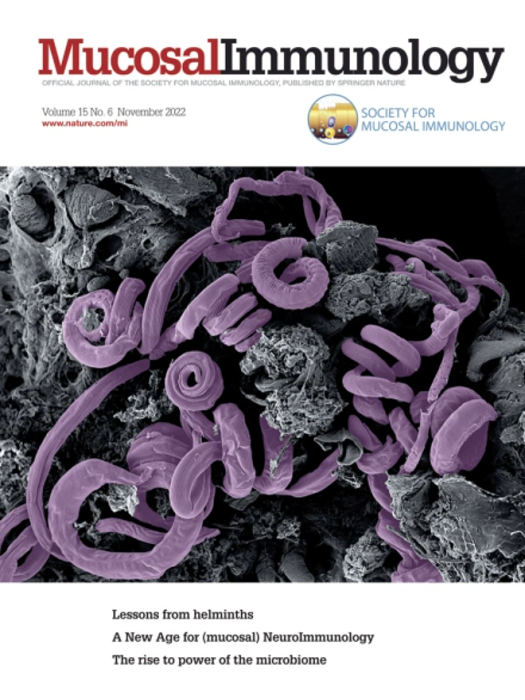微生物生态失调塑造了控制肺部炎症反应的系统性ILC3/IL-17轴。
IF 7.6
2区 医学
Q1 IMMUNOLOGY
引用次数: 0
摘要
疫苗接种和卫生方面的进步大大减少了传染病的流行和负担;然而,这些益处与自身免疫性疾病和过敏性疾病的显著增加同时发生。最近的研究通过宿主-微生物组改变的角度调查了这些相关的趋势,提出这些变化是一种潜在的解释机制。先前,我们证明万古霉素诱导的短链脂肪酸(SCFA)产生细菌的消耗导致ILC2s的过度激活和加重过敏反应。在这里,我们研究了低剂量链霉素对先天和适应性免疫细胞群及其激活状态的影响。虽然链霉素治疗的小鼠表现出正常的过敏反应,但它们对Th1/ th17介导的疾病,特别是过敏性肺炎(HP)表现出更高的易感性。其特征是肺中ILC3s和Th17细胞增加两倍,同时抗原呈递细胞(apc)在稳定状态下激活,这一效应在暴露于hp诱导剂后进一步放大。Shotgun宏基因组分析显示,链霉素诱导的生态失调降低了微生物多样性,消耗了胆红酸代谢细菌,并丰富了支链氨基酸生物合成的代谢途径,包括亮氨酸-一种已知的mTORC1激活剂。引人注目的是,给予次级胆汁酸代谢物异石胆酸(一种逆转录γ γt的激动剂)或IL-23中和抗体,逆转了对HP的增强敏感性。抑制mTORC1可显著降低Th17/ILC3反应和组织病理学。我们的研究结果强调了微生物平衡是HP易感性的关键决定因素,并揭示了IL与产生23的apc和ILC3/Th17细胞之间的正反馈回路,该回路将生态失调与持续的3型炎症机制联系起来,我们确定了一种简单、可行的干预手段。本文章由计算机程序翻译,如有差异,请以英文原文为准。
Microbial dysbiosis sculpts a systemic ILC3/IL-17 axis governing lung inflammatory responses and central hematopoiesis
Advancements in vaccination and sanitation have significantly reduced the prevalence and burden of infectious diseases; however, these benefits have coincided with a marked rise in autoimmune and allergic disorders. Recent studies have investigated these linked trends through the lens of host–microbiome alterations, proposing these shifts as a potential explanatory mechanism. Previously, we demonstrated that vancomycin-induced depletion of short-chain fatty acid (SCFA) producing bacteria results in hyperactivation of ILC2s and exacerbated allergic responses. Here we investigate the effects of low-dose streptomycin on innate and adaptive immune cell populations and their activation states. Although streptomycin-treated mice exhibit normal allergic responses, they display heightened susceptibility to Th1/Th17-mediated disease, specifically hypersensitivity pneumonitis (HP). This is characterized by a two-fold increase in ILC3s and Th17 cells in the lungs, alongside activation of antigen-presenting cells (APCs) at steady state, an effect that is further amplified upon exposure to HP-inducing agents. Shotgun metagenomic analysis revealed that streptomycin-induced dysbiosis reduces microbial diversity, depletes bile acid–metabolizing bacteria, and enriches for metabolic pathways involved in branched-chain amino acid biosynthesis, including leucine, a known activator of mTORC1. Strikingly, administration of the secondary bile acid metabolite isolithocholic acid (an inverse agonist of RORγt), or an IL-23 neutralizing antibody, reverses the enhanced susceptibility to HP. Inhibition of mTORC1 also significantly reduced Th17/ILC3 responses and histopathology. Our findings underscore microbial equilibrium as a key determinant of susceptibility to HP and uncover a positive feedback loop between IL-23-producing APCs and ILC3/Th17 cells that mechanistically links dysbiosis to sustained type 3 inflammation; and we identify a simple, actionable means of intervention.
求助全文
通过发布文献求助,成功后即可免费获取论文全文。
去求助
来源期刊

Mucosal Immunology
医学-免疫学
CiteScore
16.60
自引率
3.80%
发文量
100
审稿时长
12 days
期刊介绍:
Mucosal Immunology, the official publication of the Society of Mucosal Immunology (SMI), serves as a forum for both basic and clinical scientists to discuss immunity and inflammation involving mucosal tissues. It covers gastrointestinal, pulmonary, nasopharyngeal, oral, ocular, and genitourinary immunology through original research articles, scholarly reviews, commentaries, editorials, and letters. The journal gives equal consideration to basic, translational, and clinical studies and also serves as a primary communication channel for the SMI governing board and its members, featuring society news, meeting announcements, policy discussions, and job/training opportunities advertisements.
 求助内容:
求助内容: 应助结果提醒方式:
应助结果提醒方式:


